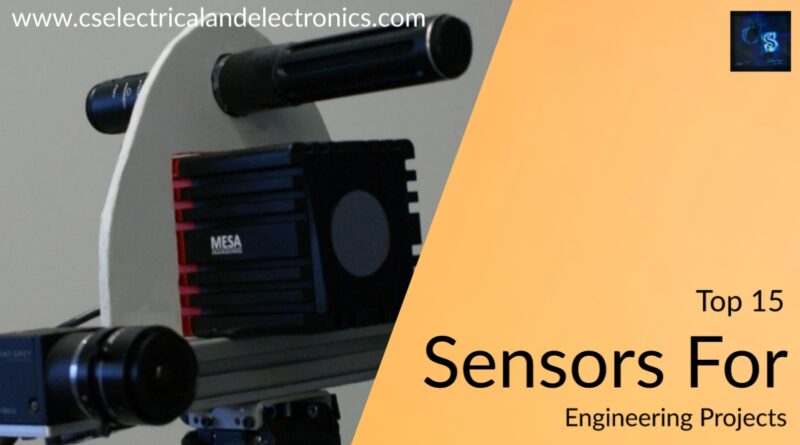Top 15 Sensors For Engineering Projects, Types Of Sensors
Hello guys, welcome back to my blog. In this article, I will discuss the top 15 sensors for the engineering projects, the types of sensors, the working, and the application of sensors for engineering projects.
If you have any doubts related to electrical, electronics, and computer science, then ask questions. You can also catch me on Instagram – CS Electrical & Electronics And Chetan Shidling.
Also, read:
- What Is Interrupt, Interrupts Handling, Interrupt Service Routine
- What Is FPGA, Field Programmable Gate Array, FPGA Tools
- Top 16 Highest Paying Engineering Jobs in the USA For Freshers
Top 15 Sensors For Engineering Projects
15. Rain Sensor
Rain sensors are switching devices that will be activated by rainfall. These works are based on the principle of total internal reflection. The LED emits the light and the photodiode receives the light. When there will be a raindrop on the windshield then the photodiode receives less light. The applications of rain sensors are mainly 2;
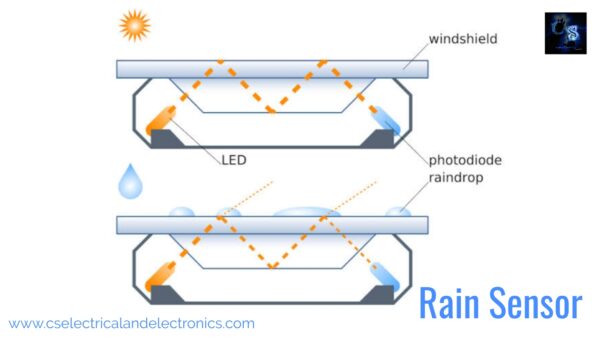
- A water conservation device is connected to an automatic irrigation system which shuts down the system in the event of rainfall.
- Rain sensors are used to protect the interior of an automobile from rain, and it supports the automatic mode of windscreen wipers.
14. PIR Sensors
PIR stands for a passive infrared sensor. It is an electronic sensor that measures infrared light radiating from an object. These are mainly used in PIR-based motion detectors. PIR sensors can be used in security alarms and in automatic lighting applications. The function of the PIR sensor is to detect general movement but it doesn’t give information on who and what has moved.
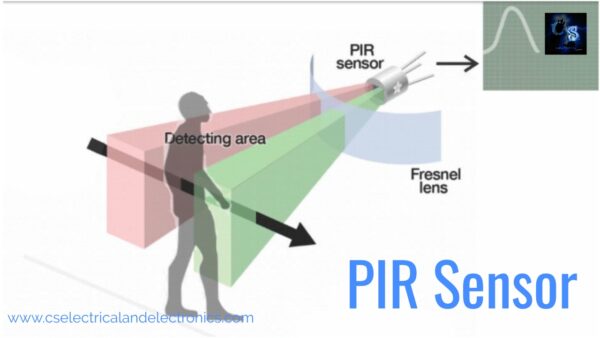
Working Of PIR Sensor
The PIR sensor has two slots in it and each slot is made up of a special material that will be sensitive to IR radiations. When the sensor is idle, both slots will detect the same amount of IR. When a warm-blooded body like a human or animal passes by, it will first intercept ½ of the PIR sensor, Which causes a positive differential charge in between two halves.
If the body leaves the sensing area then reverse happens and the sensor generates negative differential change. The objects with temperatures about absolute zero will emit heat energy, which will be in the form of radiation. This radiation is invisible to the human eye because it will radiate at infrared wavelengths. This radiation can be detected by electronic devices.
13. Gyroscope sensor
It is a type of sensor which measures and maintains the orientation and angular velocity of an object. It can measure the tilt and lateral orientation of the object. This sensor is used in mobile phones.
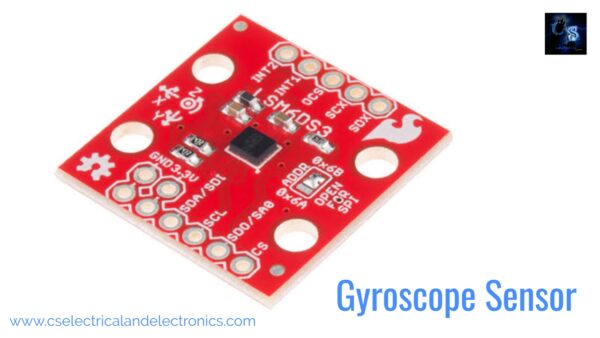
Working Of Gyroscope Sensor
Apart from sensing the angular velocity, it can also measure the motion of a particular object. To get more accurate motion sensing, gyroscope sensors will be combined with an accelerometer sensor. Coriolis force concept is used in these sensors. The working principle of the gyroscope sensor can be understood by working off a vibration gyroscope sensor. This sensor consists of a T-structure internal vibration electric field. When an alternating vibration field is applied. Continuous lateral vibrations are produced.
The vibration gyroscope consists of two arms. When one moves to leave than other moves to the right. Therefore, the leaking vibrations will cancel out. This gives the stationary part of the middle at the middle and the sensing arm will remain static. When we apply the external rotation force to the sensor, vertical vibrations are caused on drive arms. Due to this, the vibrations of the drive arms move upward and downward which results in rotational force.
This post acts on this stationary part at the center. This rotation of the stationary parts leads to vertical vibrations. These vibration measures change in electrical energy. This change is used to measure the external rotational force which will be applied to the sensor.
12. IR Sensor
IR stands for Infrared sensor. It works on the principle of emission of infrared Rays and reflected rays from the object which will be received by the receiver i.e. photodiode.
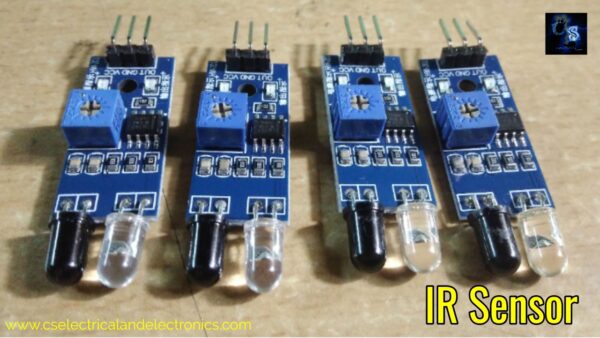
Working Of IR Sensor
IR sensor consists of an IR transmitter and IR receiver, the IR transmitter means LED which emits light, and this light after touching an object reflects back to the IR receiver i.e., a photodiode. Once the photodiode receives the light(resistance varies), it will complete the circuit and at the output, you can connect LED or buzzer.
11. Heart Beat Sensor
It is an electronic device that is used to measure heart rate.
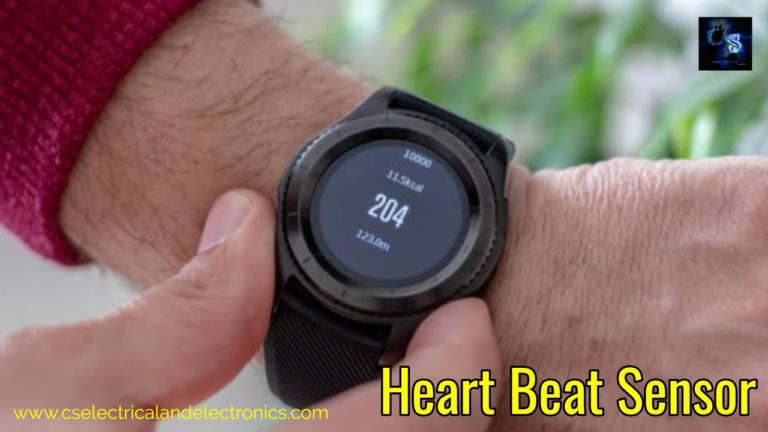
Working Of Heart Beat Sensor
It works based on the principle of photoplethysmography. It will measure the change in volume of blood through any organ of the body that causes a change in the light intensity. The flow of blood volume will be decided by the rate of pulses of the heart, and light will be absorbed by the blood.
10. Touch Sensor
It is an electronic device that captures and records the physical touch. This enables the object to detect touch, typically by a human user or operator.
Working Of Touch Sensor
It works similarly to a switch. If they are subjected to touch, pressure, or force then they get activated and acts as a closed switch. When contact is removed then they act as an open switch.
09. Water flow sensor
A large amount of water is required for industrial plants, commercial and residential buildings. To monitor the amount of water that will be supplied and used, the rate of flow of water is to be measured. For this purpose, water flow sensors are used.
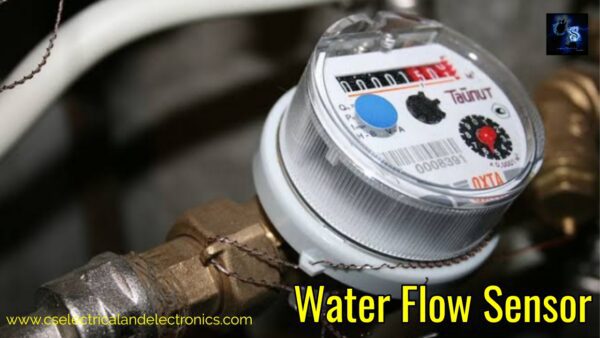
Working Of Water Flow Sensor
It consists of a plastic valve through which water can pass. When water flows through the valve, it will rotate the rotor part. By this, the rate of flow of water can be measured. Depending upon the load requirement we can change the water flow.
08. Soil moisture sensor
It is a device that measures the volumetric water contained in the soil. It is a fork-shaped probe with two exposed conductors which are variable resistors, whose resistance will be varying continuously according to the water content in the soil.
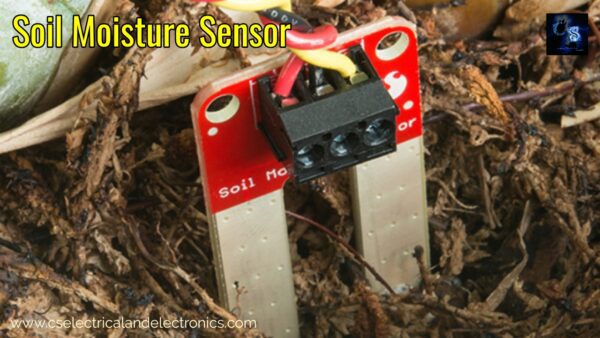
Working Of Soil Moisture Sensor
If there is more water than soil conducts more electricity, that is, there will \ be less resistance. Due to this moisture levels will be higher. The dry soil conducts poor electricity. If we have less water, then soil conducts less electricity. Therefore, the moisture level will be lower.
07. Thermistor
This is a 2 Terminal Solid State thermally sensitive transducer that allows significant change in its value of resistive, with respect to change in ambient temperature.
Working Of Thermistor
It works on the principle that states that the change in the temperature of the thermistor tends to change in resistance of the thermistor. The temperature can be changed either due to external factors or internal factors like current flowing in the device. If current increases through it then it starts self-treating its components which may result in the rise of temperature of the thermistor.
06. LDR ( photoresistor or cadmium sulfide)
This is a type of resistor whose resistance will vary depending on the amount of light falling on its surface. These resistors can be used where the sense of the presence of light is required.
Working Of LDR
This works on photoconductivity. When the light falls on the surface of LDR, the material resistance will decrease, and also the electrons which will be present in the valence band of the device will be excited to the conduction band. The photos in the incident light will have higher energy than the bandgap of semiconductor material. Due to this, electrons jump from the valence band to the conduction band.
05. Proximity Sensors
A proximity sensor is a device that is used to detect the presence of objects without any physical contact. The object for which we want to check its presence is a proximity sensor’s target.
Working Of Proximity Sensor
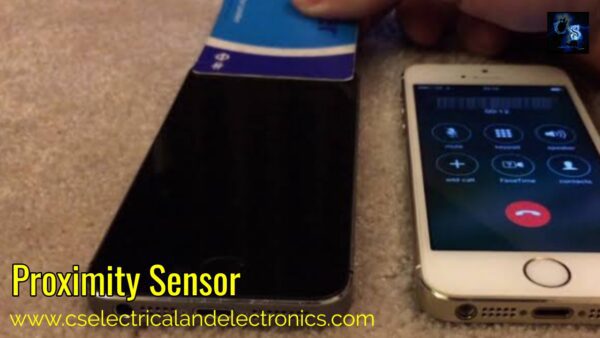
When a user is holding the phone near their face during a call, then the proximity sensor detects and turns off the display and prevents the process of keypad and battery consumption from the display. The proximity sensor will be located to the right of the earpiece.
04. Ultrasonic Sensor
It is an electronic device that measures the distance of a particular object by emitting ultrasonic sound waves and it will convert the reflected sound into an electrical signal.
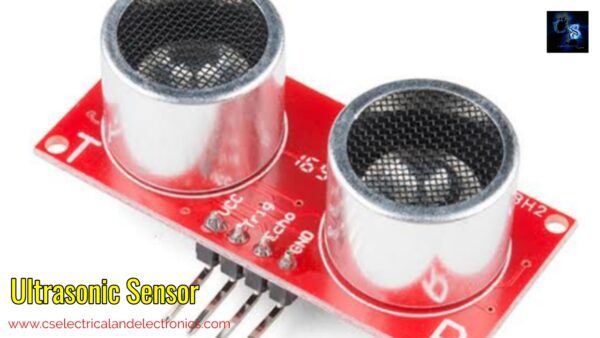
Working Of Ultrasonic Sensor
The ultrasonic sound will vibrate at a frequency about the range of human hearing. Transducers are microphones that are used to receive and send ultrasonic sound. This ultrasonic sensor uses a single transducer to send calls and also to receive the echo. The sensor will determine the distance of a targeted object just by measuring time lapses in between sending and receiving of the ultrasonic pulse.
03. Gas Sensors
It is a device that will detect the presence of a concentration of gasses in an atmosphere. Depending upon the concentration of the gas the sensor will produce a corresponding potential difference just by changing the resistance of the material which will be placed inside the sensor.
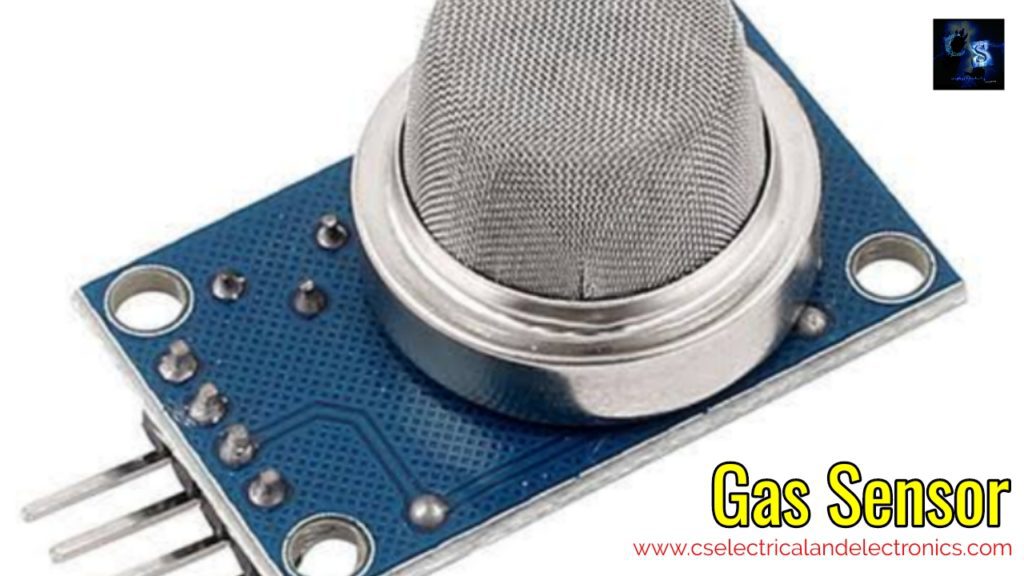
Working Of Gas Sensor
Semiconductor gas sensors on gas get into contact with a metal oxide surface and then experience either oxidation or reduction. The absorption of the gas on the metal oxide changes either the conductivity or resistivity. The metal solid surface has two electrodes, if the gas increases then the circuit will be closed and electrons flow from one electrode to another electrode.
02. Alcohol Sensor
It is a device used to detect the attentiveness of alcohol gas in the air as there will be much polluting gas in the atmosphere. The sensor conductivity increases as the polluting gas increase.
Working Of Alcohol Sensor
The alcohol sensor will consist of tin dioxide, a perspective layer inside aluminum oxide, and a heating element inside the tabular casing. If alcohol, which is present in the breath, will be oxidized into acetic acid, which will be passing through the heating element. By making use of external load resistance, the variation of the resistance will be converted into a suitable variation of voltage.
01. Color Sensor
The color sensor will detect the color of the material. This sensor will detect color on an RBG scale. It categorizes the color as right, blue or green.
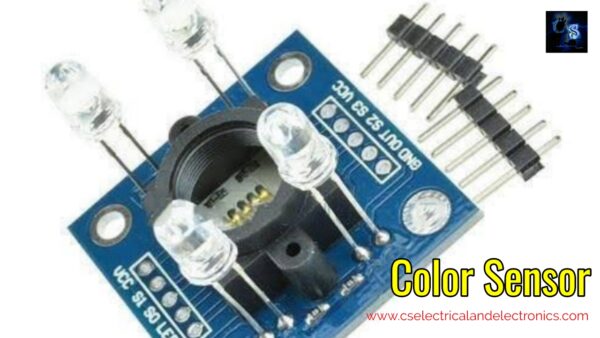
Working Of Color Sensor
We can detect the color of material by three main types of equipment that are required. A light source to illuminate the surface, A surface of which color has to be detected, and the receivers that measure the reflected wavelengths. Some filters are used in color sensors depending on the activation of the filters the color of the material will be categorized. The light to voltage Converter will be present in the sensor. The sensor will respond to color by just generating the outage that is proportional to the detected color.
I hope this article “Sensors For Engineering Projects” may help you all a lot. Thank you for reading “Sensors For Engineering Projects”.
Also, read:
- 100 + Electrical Engineering Projects For Students, Engineers
- 1000+ Electronics Projects For Engineers, Diploma, MTech Students
- 1000+ MATLAB Simulink Projects For MTech, Engineering Students
- 500+ Embedded System Projects For Engineer, Diploma, MTech, PhD
- 500+ Projects For Diploma Electrical, Electronics Student, Diploma Project
- 8051 Microcontroller Timers, TCON Register, TMOD Register
- Advancements In 3D Printing Technology And It’s Future
- Advancements In Power Electronics For Energy Efficiency
Tag: “Sensors For Engineering Projects”
Author Profile
- Chetu
- Interest's ~ Engineering | Entrepreneurship | Politics | History | Travelling | Content Writing | Technology | Cooking
Latest entries
 All PostsApril 19, 2024What Is Vector CANoe Tool, Why It Is Used In The Automotive Industry
All PostsApril 19, 2024What Is Vector CANoe Tool, Why It Is Used In The Automotive Industry All PostsApril 13, 2024What Is TCM, Transmission Control Module, Working, Purpose,
All PostsApril 13, 2024What Is TCM, Transmission Control Module, Working, Purpose, All PostsApril 12, 2024Top 100 HiL hardware in loop Interview Questions With Answers For Engineers
All PostsApril 12, 2024Top 100 HiL hardware in loop Interview Questions With Answers For Engineers All PostsMarch 22, 2024Driver Monitoring Systems In Vehicles, Working, Driver Sleepy Alert
All PostsMarch 22, 2024Driver Monitoring Systems In Vehicles, Working, Driver Sleepy Alert

